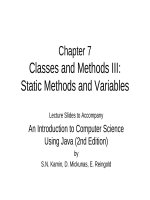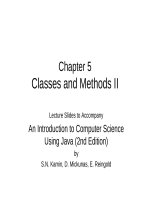Lecture An introduction to collective bargaining and industrial relations (4e) – Chapter 2: The historical evolution of the U.S. industrial relations system
Bạn đang xem bản rút gọn của tài liệu. Xem và tải ngay bản đầy đủ của tài liệu tại đây (445.69 KB, 47 trang )
Chapter
2
The Historical Evolution of
the U.S. Industrial Relations
System
McGrawHill/Irwin
An Introduction to Collective Bargaining & Industrial Relations, 4e
Copyright © 2008 The McGrawHill Companies, Inc. All rights reserved.
1 3
2 3
The Colonial and PreIndustrial Era
• MasterServant
From colonial times to the Revolutionary War,
employment principles were dominated by this
British common law
Many early settlers were indentured to a ship
owner, who sold the servant to an employer for up
to seven years
Many were forsaken husbands and wives, runaway
children, kidnapped, or criminals
1 4
2 4
The Dominance of Agriculture
• Colonial employers were eager for workers
Shortage of workers on farms and plantations
Indentured servants supplemented by slaves
1609: first slaves imported into Virginia
1808: slave trade outlawed
• At the same time, there were a growing number of
artisan services and manufacturers such as:
shopkeepers, toolmakers, blacksmiths
1 5
2 5
A Shortage of Skilled Labor
• Colonial employers complained of “excessive rates”
for skilled labor
• Employers and communities tried to lure workers
away from each other
Massachusetts Bay Colony tried to regulate
competition for workers by putting a limit on
wages
Efforts failed due to a growing demand for labor
1 6
2 6
Labor Force Diversity
• Ranged from indentured servants, slaves, immigrants,
skilled artisans, shopkeepers, and farmers of both
sexes and color
• Diversity reduced the class consciousness that helped
unions develop in Europe
• Expanding opportunity meant little interest in unions
in the preindustrial 18th century
1 7
2 7
Early Unionism
• Developed with the industrial revolution
• Early mills imposed strong discipline and
socialization on immigrants
• Rules of the Lawrence Manufacturing Co:
“No person can be employed ...whose known
habits are or shall be dissolute, indolent, dishonest,
intemperate, or who habitually absent themselves
from public worship...or who may be addicted to
gambling of any kind”
1 8
2 8
The First Trade Unions
• First groups were skilled craftsmen
• First modern trade union in the U.S. was the Federal
Society of Journeymen Cordwainers (shoemakers) in
Philadelphia in 1794
• Later joined by printers, carpenters, and other artisans
in New York and large cities
1 9
2 9
Why Workers Formed Unions
• John Commons: Competitive pressures spurred
unionism
Expansion of markets, innovations in
transportation, and unity of production decreased
the need for artisans and lowered wages
Unions were a reaction to lower wages and
deteriorating working conditions
1 10
2 10
Early Court Reaction to Unions
• Employment relationships were governed by common
law
• No state or constitutional provisions addressed the
rights of workers or obligations of employers
• Most courts were hostile toward collective action by
labor organizations
1 11
2 11
The Conspiracy Doctrine
• Actions of the shoemakers union led to a famous trial
in 1806
• This court ruling dominated until the 1840s
• Cordwainers refused to work with people not
members of their association
• Jury found them guilty of a criminal conspiracy; they
impinged upon a worker’s “freedom” to contract with
an employer
1 12
2 12
PreCivil War Organizing Efforts
• Criminal conspiracy doctrine and depression after the
War of 1812 led to the disappearance of most early
unions
• Workingmen’s political parties were founded circa the
1820s
• Two largest in New York and Philadelphia
• They failed to establish a strong coalition
1 13
2 13
Labor’s Economic Advances
• New England workers limited child labor
• Working from “can’t see to can’t see” stops
• 10hour day implemented
• National Trade Union created with the goal to bring
separate unions together
Met in 1832 & 1837, then collapsed
• Ethnic diversity made organization difficult
1 14
2 14
The Utopian Movements
• Mid to late 1800s: Utopians proposed communities of
citizens, workers, and managers to work together
• Aimed to avoid the divisive factory system
• Horace Greeley: Famous Utopian thinker
• But rising wages and the westward movement limited
Utopian appeal
1 15
2 15
The MeansEnd Doctrine
• Court interpretations on unionism changed
• Commonwealth v. Hunt: A landmark case
• Unions were not illegal per se conspiracies
• Test: Did unions abuse power or violate constitutional
rights of the workers?
• Unions had a right to exist, but were now faced with
injunctions on strikes & boycotts
• Ruling helped but didn’t eliminate barriers
1 16
2 16
The YellowDog Contract
• Employers required a loyalty oath
• The oath stated that the employee would not join or
participate in union activities
• Courts could enforce these common law contracts,
and the employee could be fired
• They also formed the basis for legal action against
organizers for interfering with a contractual
relationship
1 17
2 17
The Labor Wars
• From 1860 through 1910 there was a series of bitter
struggles between workers and their employers
• Some were local, others national
• Coal fields were the most violent
• Worker rebellions following unilateral wage cuts of
up to a third
1 18
2 18
The Molly Maguires
• A secret association of militant Irish miners
• Formed in 1862 to help striking miners resist wage
cuts
• Lasted 10 years; infiltrated by a spy who implicated
them in murder and ten were executed
• Other strife found in railroads, steel, meatpacking,
and manufacturing
• Workers had militant supporters such as Mother Jones
1 19
2 19
The Haymarket Affair
• Outburst of violence in Chicago in 1866
• Tensions rose after the McCormick Harvester Works
lockout
• Rally of 4,000 following killing of four at plant picket
line
• Police killed 10, wounded 50 following a bomb blast.
Eight anarchists were convicted, four hanged, though
no evidence was presented
1 20
2 20
The Homestead Strike
• Directed against Carnegie Steel in 1892
• The Amalgamated Association of Ironworkers
reached an impasse
• Carnegie demanded a steep reduction in wages
• Carnegie hired 300 Pinkerton guards that were
confronted by the workers
• 12 killed on each side; strike failed after union ran
out of money
1 21
2 21
The Pullman Strike
• Led by Eugene Debs, the American Railway Union
had 150,000 members in the 1890s
• Depression of 1893: the Pullman Palace Car company
cut workers’ wages by 22% without reduction in rents
on company housing
• Company fired workers who tried to negotiate wage
increases, starting a strike nationwide
• President Cleveland sent troops to enforce court
injunction
• Strike was lost, and Debs – known as a leading
socialist went to jail
1 22
2 22
The Need for National Unions
• As transportation spread across the country,
employers could easily transfer work
• Local strikes had little power
• National trade unions were formed, such as the
American Railway Workers
• Membership fluctuated with the economic
environment
1 23
2 23
The Knights of Labor
• Emerged as one of the most important early national
labor movements in 1869
• Organized labor across craft
• All workers had common interests, regardless of skill
or occupation
• Favored harmony & arbitration vs. strikes
• Peaked at 700,000 in 1886, then declined due to
policy disputes & Haymarket Square
1 24
2 24
Industrial Workers of the World
• IWW provided workers with a radical alternative
• Favored creation of an independent political party
• Prone to violence & favored the overthrow of the U.S.
Government
• Leader “Big Bill” Haywood opposed World War I
• Haywood and other activists were tried for sedition,
and IWW faded from the public scene
1 25
2 25
Injunctions and Antitrust Rulings
• Early 1900s: Union actions found in violation of new
antitrust legislation
• Sherman Antitrust Act of 1890 declared “every
contract, combination, or conspiracy” that restrained
trade illegal
• Business monopolies were the target of the law, but
courts applied Sherman to the unions









